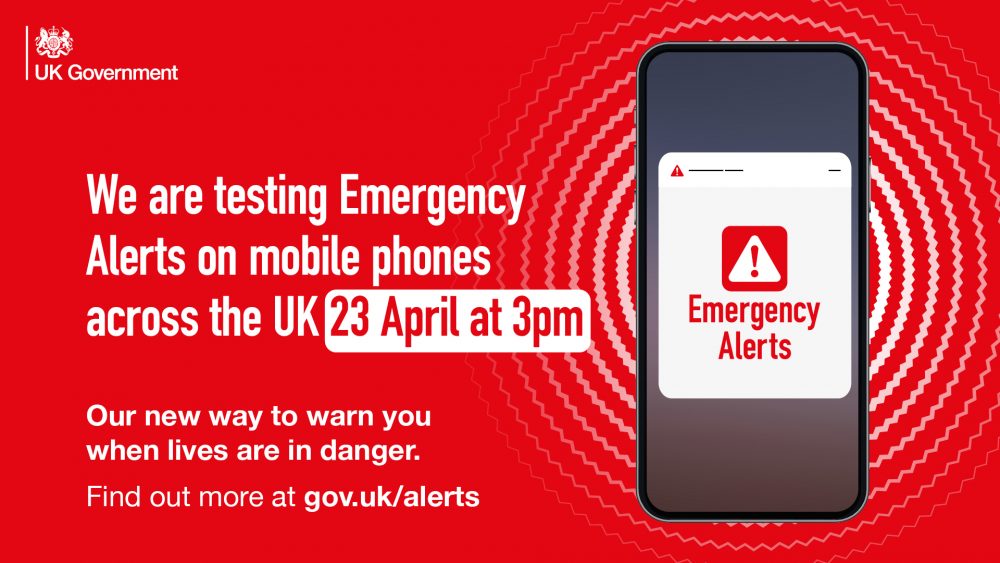Update: Emergency Alerts

The UK government’s new Emergency Alerts system is live and will enable people to be contacted via their mobile phone when lives are in danger. To ensure the Emergency Alerts system works effectively, the Government will be carrying out a nationwide test on Sunday 23rd April between 3-3:30pm.
It will be used to warn you in the event of emergencies, such as severe flooding.
Emergency Alerts are sent to all compatible mobile phones within an area of risk. They don’t track your location, need your phone number, or collect personal data. Only the government and the emergency services will be able to send them. If you don’t have a mobile phone, you’ll still be kept informed through other channels.
If you get an Emergency Alert on your phone, you’ll hear a loud, siren-like sound. A message on your screen will tell you about the emergency and how best to respond. You’ll be able to check an
alert is genuine at gov.uk/alerts
What are Emergency Alerts?
The UK government’s new Emergency Alerts system is live and will enable people to be contacted via their mobile phone when lives are in danger. The service will be used to warn you about life-threatening emergencies such as severe flooding.
What will the alert look and sound like?
An Emergency Alert looks and sounds very different to other types of messages such as SMS ‘text messages’. You’ll know if you get an Emergency Alert because you’ll hear a loud, siren-like sound and your phone will use a distinct vibration. A message will appear on your screen until you acknowledge it.
What is the purpose of the test alert?
To ensure the Emergency Alerts system works effectively, the government will be carrying out a nationwide test on Sunday 23rd April between 3-3:30 pm.
Can I opt out?
Emergency Alerts use several channels and the ability to opt in or out is determined by the channel type. However, we strongly recommend that people do not opt out of the service, as it is intended to warn you when lives are in danger.
Opt out Android phones and tablets:
● To opt out, search your settings for ‘emergency alerts’ and turn off Severe alerts and Emergency alerts.
● If this does not work, contact your device manufacturer
How can I find an Emergency Alert on my phone after I’ve acknowledged it?
If you received an Emergency Alert on a compatible phone, you may still be able to view it on your phone after you have acknowledged it. On Android phones, the alert may be found in the Messages app or ‘Emergency Alert History’. For iPhone users, the alert will be in your notifications. You can access your notifications by swiping down from the top of your screen. If you delete your notifications, the alert will also be deleted.
How do they work?
Emergency Alerts are sent to compatible 4G and 5G mobile phones within an area of risk. They don’t need your location or phone number. Only the government and emergency services can send
them.
Will I still receive an alert if I have an old phone?
Emergency Alerts are sent to compatible 4G and 5G mobile phones within an area of risk, if they have the latest software update. Mobile phones released before 2015 are likely to require some
changes to the settings.
Is my privacy and security protected?
Yes: Emergency Alerts require no personal information (such as telephone number, identity or location). The technology used allows a message to be broadcast to a defined area, meaning any compatible device in or entering that area immediately receives the message. Emergency alerts are therefore one-way and do not provide any feedback on the recipients’ location or whether they have received an alert. The recipients’ telephone numbers and specific locations are not required, known or used, and no personal information on recipients of Emergency Alerts is shared by the Mobile Network Operators and no personal information is gathered by the government or the Mobile Network Operators.
What is the difference between SMS and Emergency Alerts?
After the alert is sent by the government or emergency services, the message will be received on a mobile phone within about 4 to 10 seconds. In comparison, the delivery of SMS messages can take up to 48hrs. This is critical in emergencies. Emergency Alerts are one-way and no personal information is required, whereas an SMS message requires a phone number.
What languages will messages be broadcast in?
The primary language will be English. Sending dual language English/Welsh messages is also possible for alerts in Wales. We will continue to investigate the use of the technology for messages sent in other languages to increase the effectiveness and reach of the service.
What are test alerts?
To ensure the Emergency Alerts system works effectively, the government may occasionally carry out a test of the service.
To learn more about Emergency Alerts, look out for the nationwide information campaign and visit gov.uk/alerts
: